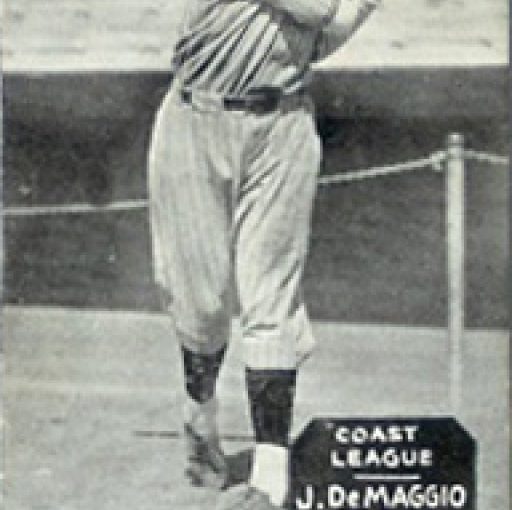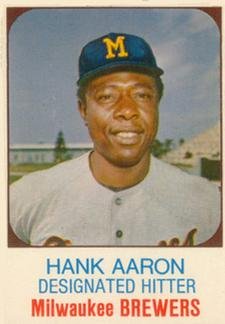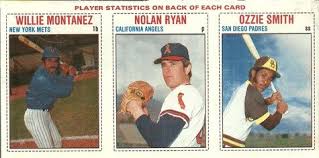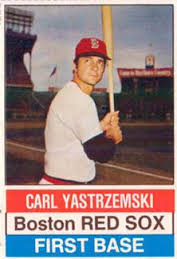The 1975 Boston Red Sox and Cincinnati Reds team sets are absolute musts for 1970s baseball card collectors. Not only did the two teams engage in one of the most memorable World Series to date, but the sets include some of the top players from the ‘70s — including Hall of Famers, the all-time hits leader, and two of the top rookies in Red Sox history.
After raising the price of baseball card packs from 10 cents to 15 cents, Topps was looking for a way to turn heads. Collectors had been complaining for years that Topps baseball cards were becoming boring and monotonous. After featuring plain white borders in consecutive years, Topps broke out the rainbow for the 1975 series. Bright two-color borders with bold lettering turned out to be a one-year wonder. But the unique series stood the test of time, remaining one of the most memorable sets ever produced with some help from the Red Sox and Reds.
Thirty-four-year-old Luis Tiant twisted and turned his way to a 6-0 victory in Game 1 of the 1975 World Series. With his best days believed to be in the past, Tiant transformed from a power pitcher to a craftsman, offering an assortment of breaking balls and off-speed pitches that kept hitters off balance. With the DH shelved for the series, Tiant also picked up his first hit since 1972. His 1975 Topps card (#430) is a quick sell locally for $3.
Sparky Anderson’s Reds took three of the next four games to set the stage for Game 6, arguably the most dramatic game in World Series history. The Red Sox took a 3-0 lead in the first inning when Fred Lynn homered into the Fenway bleachers following two-out singles to Hall of Famers Carl Yastrzemski and Carlton Fisk. Graded versions of the ‘75 Topps Yaz (#280) and Fisk (#80) cards sell in the $25-30 range.
After batting .331-21-105, Lynn became the first Major League player to capture MVP and Rookie of the Year honors in the same season. His ‘75 Topps rookie (#662) now sells for $6 in mint condition. Teammate and fellow rookie Jim Rice slugged .309-22-102 before taking an errant Vern Ruhle fastball off the wrist, ending the left fielder’s season in early August. Elected to the Hall of Fame in his last year of eligibility in 2009, Rice continues to be a local favorite. His ‘75 Topps rookie (#616) sells for $9.
Ken Griffey Sr.’s two-run triple and HOF catcher Johnny Bench’s RBI single in the fifth inning tied Game 6. Griffey’s ‘75 Topps card (#284) — often packaged on eBay with Ken Griffey Jr.’s cards — sells for $3 as a stand alone. The Bench card sells for $25 in mint condition. The Reds took a 6-3 lead in the eighth following a home run by Cesar Geronimo whose ‘75 Topps card can be found in the commons bin. With two outs in the bottom of the eighth, Bernie Carbo drilled a Rawly Eastwick pitch into the centerfield bleachers to tie the game at six. Carbo has a bit of a cult-like following locally, inflating his ‘75 Topps card (#379) slightly above common status.
In the 11th inning with one out and fleet-footed Griffey on first, Cincinnati All-Star second baseman Joe Morgan slashed a sinking liner toward the right field ple. The ball seemed destined to drop into the corner for an extra base hit that would have scored Griffey. With an instinctive over-the-head stab of the glove, Dwight Evans plucked the ball out of the Boston night. He stumbled backward, regained his balance and threw to the infield to double up Griffey at first base.
With the tie preserved and the tension building, America was introduced to one of baseball’s greatest right fielders. His ‘75 Topps card (#255) is a great buy for $2. Hall of Fame second baseman Joe Morgan accumulated two World Series rings and two MVP awards during a 22-year career. His ‘75 Topps sells for $4.
In the bottom of the 12th, Fisk sent a blast to left field. The question: fair or foul? The ball ricocheted off the foul pole for the perhaps the most dramatic moment in Red Sox history. The Reds would go on to win Game 7 to win the World Series, but the series — Game 6 in particular — will long be recounted by generations of Red Sox fans. The Red Sox 1975 Topps team set sells for $50 in decent condition, while the Reds team set, which includes Pete Rose (#320), goes for $75.




 ndling.
ndling. the nation’s bicentennial, the Hostess 1976 set includes red, white and blue stripes surrounding the player’s name, team and position. Collectors familiar with the 1976 Topps set will recognize some of the same photos in the Hostess series. The set is loaded with stars, including Brett, Nolan Ryan, Pete Rose, a Dennis Eckersley rookie and one of Hank Aaron’s final cards.
the nation’s bicentennial, the Hostess 1976 set includes red, white and blue stripes surrounding the player’s name, team and position. Collectors familiar with the 1976 Topps set will recognize some of the same photos in the Hostess series. The set is loaded with stars, including Brett, Nolan Ryan, Pete Rose, a Dennis Eckersley rookie and one of Hank Aaron’s final cards.